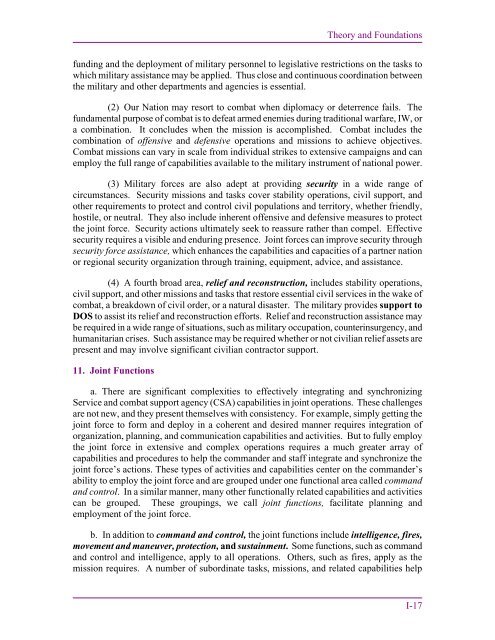JP 1, Doctrine for the Armed Forces of the United States - Defense ...
JP 1, Doctrine for the Armed Forces of the United States - Defense ...
JP 1, Doctrine for the Armed Forces of the United States - Defense ...
You also want an ePaper? Increase the reach of your titles
YUMPU automatically turns print PDFs into web optimized ePapers that Google loves.
Theory and Foundations<br />
funding and <strong>the</strong> deployment <strong>of</strong> military personnel to legislative restrictions on <strong>the</strong> tasks to<br />
which military assistance may be applied. Thus close and continuous coordination between<br />
<strong>the</strong> military and o<strong>the</strong>r departments and agencies is essential.<br />
(2) Our Nation may resort to combat when diplomacy or deterrence fails. The<br />
fundamental purpose <strong>of</strong> combat is to defeat armed enemies during traditional warfare, IW, or<br />
a combination. It concludes when <strong>the</strong> mission is accomplished. Combat includes <strong>the</strong><br />
combination <strong>of</strong> <strong>of</strong>fensive and defensive operations and missions to achieve objectives.<br />
Combat missions can vary in scale from individual strikes to extensive campaigns and can<br />
employ <strong>the</strong> full range <strong>of</strong> capabilities available to <strong>the</strong> military instrument <strong>of</strong> national power.<br />
(3) Military <strong>for</strong>ces are also adept at providing security in a wide range <strong>of</strong><br />
circumstances. Security missions and tasks cover stability operations, civil support, and<br />
o<strong>the</strong>r requirements to protect and control civil populations and territory, whe<strong>the</strong>r friendly,<br />
hostile, or neutral. They also include inherent <strong>of</strong>fensive and defensive measures to protect<br />
<strong>the</strong> joint <strong>for</strong>ce. Security actions ultimately seek to reassure ra<strong>the</strong>r than compel. Effective<br />
security requires a visible and enduring presence. Joint <strong>for</strong>ces can improve security through<br />
security <strong>for</strong>ce assistance, which enhances <strong>the</strong> capabilities and capacities <strong>of</strong> a partner nation<br />
or regional security organization through training, equipment, advice, and assistance.<br />
(4) A fourth broad area, relief and reconstruction, includes stability operations,<br />
civil support, and o<strong>the</strong>r missions and tasks that restore essential civil services in <strong>the</strong> wake <strong>of</strong><br />
combat, a breakdown <strong>of</strong> civil order, or a natural disaster. The military provides support to<br />
DOS to assist its relief and reconstruction ef<strong>for</strong>ts. Relief and reconstruction assistance may<br />
be required in a wide range <strong>of</strong> situations, such as military occupation, counterinsurgency, and<br />
humanitarian crises. Such assistance may be required whe<strong>the</strong>r or not civilian relief assets are<br />
present and may involve significant civilian contractor support.<br />
11. Joint Functions<br />
a. There are significant complexities to effectively integrating and synchronizing<br />
Service and combat support agency (CSA) capabilities in joint operations. These challenges<br />
are not new, and <strong>the</strong>y present <strong>the</strong>mselves with consistency. For example, simply getting <strong>the</strong><br />
joint <strong>for</strong>ce to <strong>for</strong>m and deploy in a coherent and desired manner requires integration <strong>of</strong><br />
organization, planning, and communication capabilities and activities. But to fully employ<br />
<strong>the</strong> joint <strong>for</strong>ce in extensive and complex operations requires a much greater array <strong>of</strong><br />
capabilities and procedures to help <strong>the</strong> commander and staff integrate and synchronize <strong>the</strong><br />
joint <strong>for</strong>ce’s actions. These types <strong>of</strong> activities and capabilities center on <strong>the</strong> commander’s<br />
ability to employ <strong>the</strong> joint <strong>for</strong>ce and are grouped under one functional area called command<br />
and control. In a similar manner, many o<strong>the</strong>r functionally related capabilities and activities<br />
can be grouped. These groupings, we call joint functions, facilitate planning and<br />
employment <strong>of</strong> <strong>the</strong> joint <strong>for</strong>ce.<br />
b. In addition to command and control, <strong>the</strong> joint functions include intelligence, fires,<br />
movement and maneuver, protection, and sustainment. Some functions, such as command<br />
and control and intelligence, apply to all operations. O<strong>the</strong>rs, such as fires, apply as <strong>the</strong><br />
mission requires. A number <strong>of</strong> subordinate tasks, missions, and related capabilities help<br />
I-17

















